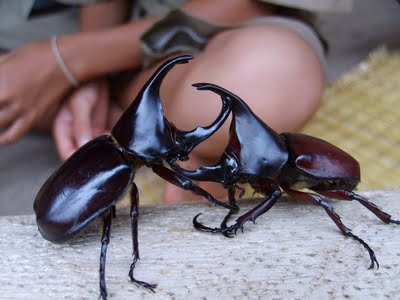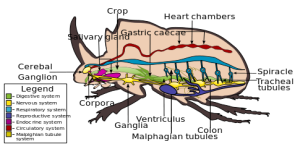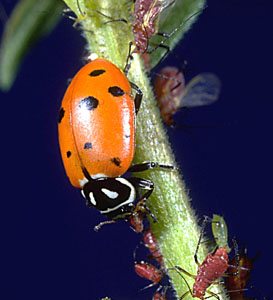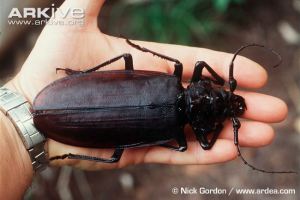Coleoptera – Introduction
Coleoptera, or more well-known as the beetle insect-subgroup, is the order of insects that holds one of the most diverse and largest number of known organism species compared to any other group of organisms, with over 350,000 currently discovered species. The word Coleoptera itself means “sheath”, and is derived from the greek word koleos, and describes beetles’ characteristics to have two pairs wings, with a front hard pair of wings that over-cover and “sheath” a second pair of delicate back wings underneath when not in use (diagram and more explained in the next section under characteristics).
 As a characteristic of being the largest group of insects, many types of Beetles are understandably incredibly diverse in their functions and roles — performing crucial and unique roles for their environment separate from their standard service as a food for many organisms in the food chain. One such example of a beetle is the dung beetle, which was discovered to feed and reproduce in the dung of herbivores, and inadvertently are responsible for removing millions of tons of dung. Left intact, the dung would otherwise most likely destroy acres of valuable pastureland and other natural areas.
As a characteristic of being the largest group of insects, many types of Beetles are understandably incredibly diverse in their functions and roles — performing crucial and unique roles for their environment separate from their standard service as a food for many organisms in the food chain. One such example of a beetle is the dung beetle, which was discovered to feed and reproduce in the dung of herbivores, and inadvertently are responsible for removing millions of tons of dung. Left intact, the dung would otherwise most likely destroy acres of valuable pastureland and other natural areas.
Here in the image below is a dung beetle, which has rolled up a ball of dung in preparation for dung consumption. However, interestingly enough, during hot times it is discovered that the dung balls dung beetles roll unexpectedly act as a sort of AC unit and cool them beetles off by absorbing the beetle’s heat and releasing it to rest of the atmosphere (more at http://blogs.scientificamerican.com/observations/2012/10/22/booted-dung-beetles-reveal-clever-cooling-video/).

Beetles are also objects of fascination as we learned in class, serving as collector items for many types of collectors — from scientists like Drawin in the 1800’s, to many different types of natural history museums today.
Furthermore, Beetle collecting and keeping is actually is still a very popular activity and past-time in Japan, whose summers provide hospice to a diverse case of insects that elementary and middle school students reportedly go out and catch for fun!

Image 1: http://thegeografist.com/wp-content/uploads/2013/09/Fiddler_beetle_morphology_diagram.svg_.png
Image 2: http://blogs.scientificamerican.com/observations/files/2012/10/beetleboots1.jpg
Image 3: http://2.bp.blogspot.com/-kem_Mo-fHq4/UGwLPvoN4ZI/AAAAAAAAB4c/vqu59HJl68w/s640/Kabutomushi.jpeg
Links: http://www.ucmp.berkeley.edu/arthropoda/uniramia/coleoptera.html, http://www.cals.ncsu.edu/course/ent425/library/compendium/coleoptera.html, http://www.coleoptera.org/p1058.htm, http://web-japan.org/kidsweb/archives/cool/99-07-09/beetles.html
Characteristics of Coleoptera
The order Coleoptera has many fascinating characteristics. One such trait is that the members of this order possess two hind thoracic segments, the mesothorax and the metathorax. These two thoracic segments are connected with the abdomen. This is a deviation from the standard head-thorax-abdomen format and is inherently unique to Coleoptera.
Members also have genitalia which retracts into the abdomen and have adult antenna. The most defining characteristic of this order, however, is the hardening of their forewings into elytra. The purpose behind the elytra is to protect the delicate hind wings, the dorsal side of the abdomen and allow the beetles to be able to fit through narrow surfaces, such as bark and crevices in walls. Below is an example of the Fore and Hind wings of Coleoptera.
Furthermore, members of this order fall under the category of Holometabola. In other words, they undergo complete development, which means there growth follows this pattern: egg->larva-> pupa->adult.
For visual learners, below is a chart that summarizes this order perfectly:
Links: http://tolweb.org/coleoptera, http://cedarcreek.umn.edu/insects/albumframes/024frame.html
Image 1: © David R. Maddison, Image 2: © NC State University
Internal Body Systems of Coleoptera
 Basic Internal Anatomy of a beetle
Basic Internal Anatomy of a beetle
Within a beetle there are many different aspects of the body system that work together to create the fully functioning organism. These include the digestive system, the nervous system, the respiratory system, and the circulatory system.
A beetles digestive system is based off of the certain species feeding habits. For example, a herbivorous beetle’s digestive system works to break down plant material whereas a predatory beetles digestive system will work slightly differently. Beetles have an “alimentary” canal in their throats which is situated in front of the midgut, which is therefor in front of the hindgut.
The nervous system may vary depending on the species of beetle, but generally contain three thoracic and seven/eight abdominal ganglia which all combine to form a single structure.
The respiratory system of beetles operates by inhaling Oxygen and exhaling Carbon Dioxide. Some beetles that swim can even bring an “air-bubble” down with them in order to breathe under water!

Dytiscidae are part of the family of diving beetles that create bubbles of air that allow them to stay underwater for longer periods of time
A beetles circulatory system is just like most other insects in the way that is an open circulatory system. They use hemolymph instead of blood, which is a fluid much like a combination of blood and interstitial fluid. Throughout the length of its body, there are ostia, which helps circulate hemolymph, much like how a humans veins and arteries circulate blood.
image 1:http://en.wikipedia.org/wiki/Beetle#mediaviewer/File:Internal_morphology_of_Coleoptera.svg
image 2: https://c1.staticflickr.com/7/6099/6237874871_58193ce4a1_z.jpg
links: http://en.wikipedia.org/wiki/Beetle, http://science.jrank.org/pages/808/Beetles-Beetle-anatomy-physiology.html
Families of Coleoptera
With Coleoptera being the largest order in the animal kingdom, it’s very logical that several different families of beetles exist, with ten major families making up about 70% of all beetles found within North America. Some of these families include the Scarabaeidae, Coccinellidae, and Cerambycidae classifications.
For the Scarabaeidae family, some key characteristics include having lamellate antennae, which are thin and kinked into a rough L-shape, and spiny legs. As somewhat indicated by the name, scarab beetles dominate, and in a sense define, this family, with over 1000 species existing in North America. These beetles are herbivores, thus they are found in soil/on plants and include many pest species.
The Coccinellidae family is the family of the ladybug (or ladybird). The most noticeable characteristic of these beetles are their colors/spots, which vary between a red base with black spots and black with red spots. While they may not seem so due their perception by common culture, these seemingly harmless, lucky bugs are actually very predatory creatures that eat aphids and scale insects. There are over 5000 species of Coccinellids found worldwide.
Longhorned beetles belong to the Cerambycidae family, and like most other families are herbivores. The key characteristic of this class is their very long antennae, which are usually as long, if not longer, than body of the beetle. Their larvae are all woodborers, which can cause significant structural damage to trees and wood. This family possesses the titan beetle, which can grow up to 6.6 inches in length, and is commonly thought of as one the largest insects discovered.






seriously badass article guys
Love the article! My favorite part is the section on the ecological importance of dung beetles. Coming from a background in farming, i know how important certain species are to maintaining pest population. ESPM Twitter: @jsdp94
I love the images. the dung beetle looks like he has shoes on. The information gives a better perspective on the importance of beetles.